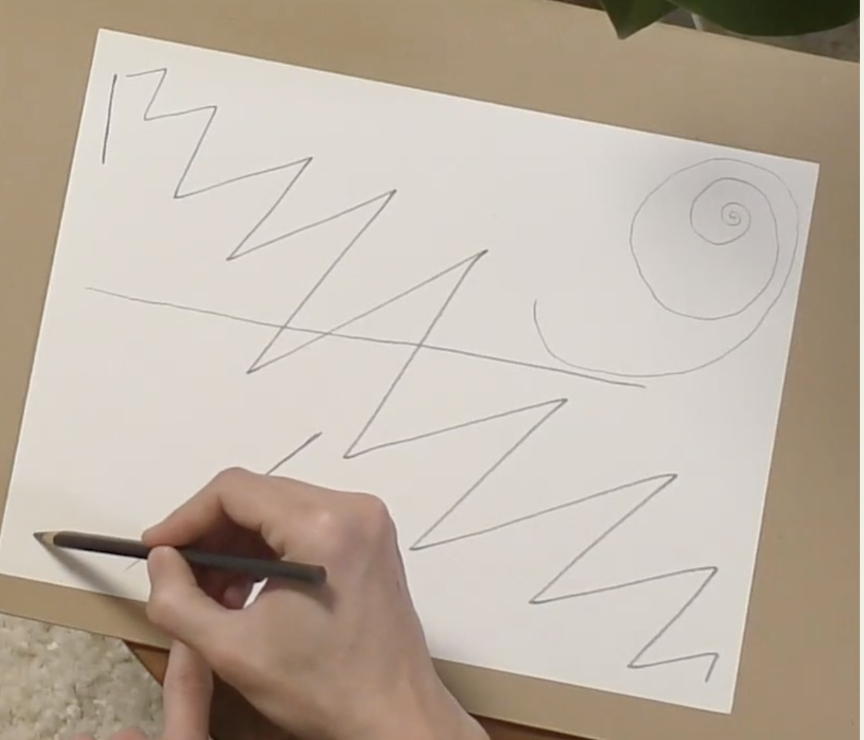Overview
In this lesson, students will identify and draw different types of lines.
Materials and Tools
- Pencil
- One piece of paper
- Looking for Lines video
- Looking for Lines student slides
Objectives
- Students will be introduced to four elements of art: line, shape, color, and pattern
- Students will look closely to find line, shape, color, and pattern, then draw each
Students will create artworks using different lines, shapes, colors, and patterns
Students will understand that:
- There are many different types of lines, and they can be found everywhere
Students will be able to:
- Use pencils to make a variety of lines
- Observe and draw different lines that they find
Activities
Note: The following steps are written with sample language you may use with your students as you go through the lesson. Explain to students that the slides and the video they see during the lesson will be shared with them so they can review the lesson on their own and continue to make more art.
Step 1: Introduce Line Scavenger Hunt (5 minutes)
Hello, artists. Today we are going to put on our close-looking goggles and go on a line scavenger hunt! We will look for lines in our environment, but first let’s find some lines on our bodies. Let’s start by looking at the palm of your hand. What do you see? I notice many curved lines that show the folds and wrinkles of my skin. How about you?
- Can you find other kinds of lines on your palm?
- Can you find any straight lines?
- Any bent lines?
Take a moment to draw the lines you observe on your paper. As you draw, think about the length and thickness of the lines that you are observing.
Now flip your hand around. What new lines can you find? I notice the skin around my knuckles looks like spirals!
Step 2: Watch Looking for Lines Video (13 minutes)/Independent Work (12 minutes)
For more inspiration let’s watch a video of Daniel, a Studio in a School teaching-artist, going on a scavenger hunt for lines. As you watch, notice the way Daniel looks closely at his environment. You also will be looking closely at your surroundings and searching for interesting lines. Like Daniel, you may want to begin by observing the floor. Have fun on your scavenger hunt and remember to draw all the different lines that you find!
Step 3: Drawing Activity, with Student Slides #4-6 (10 minutes)
Now that we have collected different lines in our environment, let’s have a bit more fun. Closely observe the lines you collected on your paper. Let’s try labeling them using the line chart from Slide #4 of your Student Slides.

- Did you find a bumpy, curly, or zigzag line?
If you didn’t this time around, don’t worry. Next time you go for a walk, keep your eyes open for new kinds of lines. In the meantime, on a separate sheet of paper let’s invent or make up new lines from our observed lines.
In my scavenger hunt, I found wavy and thick lines. I think I will combine them and make a line that is both wavy and thick.
Now it’s your turn. Try combining your lines to make five new lines. Look at Slides #5 and #6 for more inspiration.


Step 4: Reflection Questions for Discussion (10 minutes)
- What was the most surprising line you found in your scavenger hunt?
- Where did you find it?
- Which line is your favorite?
- Point to your favorite line in the middle of your paper? Did you draw it anywhere else?
- Did you explore overlapping lines? How do these lines look different from lines that are next to each other?
Step 5: Extension Activity, with Student Slides #7-8
Hmm…I’m noticing that I have some empty space on my paper. I think it’s just the right amount to explore lines a bit more. To begin, find our favorite line and draw it again. As you draw, see what you can change about it.
I think I’ll make my thick wavy line very small and thin this time.
- How will you change your favorite line?
Look at Slides #7 and #8 to see how Daniel explored ways to change his favorite line.


Here are some more ideas:
- Draw new lines on different parts of your paper (top, middle, bottom, corner).
- Experiment with drawing lines that go in different directions.
- Explore lines that cross over each other and lines that connect.
- What other ideas do you have?
Vocabulary
Line
Straight
Wavy
Zigzag
Bumpy
Curved
Spiral
Thick
Thin
Resources


